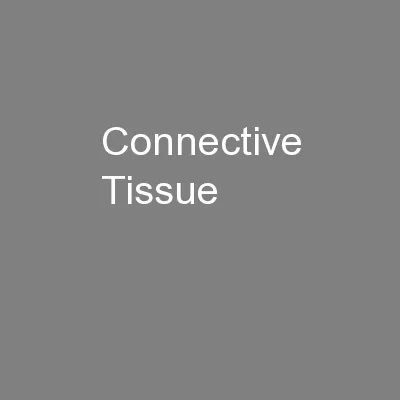

The dense layer of the basal lamina of all epithelial tissue is created by connective tissue Connective tissue connects the epithelium to the rest of the body Three Basic Components Specialized cells ID: 246407
Download Presentation The PPT/PDF document "Connective Tissue" is the property of its rightful owner. Permission is granted to download and print the materials on this web site for personal, non-commercial use only, and to display it on your personal computer provided you do not modify the materials and that you retain all copyright notices contained in the materials. By downloading content from our website, you accept the terms of this agreement.
Slide1
Connective Tissue
The dense layer of the basal lamina of all epithelial tissue is created by connective tissue.
Connective tissue connects the epithelium to the rest of the body.Slide2
Three Basic Components
Specialized cells
Fibroblasts
Adipocytes
Extracellular protein fibers
Collagen fibers
Reticular fibers
Elastic fibers
A fluid known as
ground substanceSlide3
Functions of Connective Tissue
Establishing a
structural framework
for the body.
Transporting
fluids and dissolved minerals.
Protecting
delicate organs.
Supporting, surrounding, interconnecting
other types of tissue.
Storing
energy reserves
Defending
the body from invading microorganisms.Slide4
Classification of Connective Tissues
Classified based on their
physical
properties. Three categories:
Connective Tissue Proper
Ex. Adipose tissue
Fluid Connective Tissue
Ex. Blood and Lymph
Supportive Connective TissueEx. Cartilage and boneSlide5
Connective Tissues
Connective Tissue Proper
Fluid Connective Tissues
Supporting Connective Tissues
LOOSE
DENSE
Fibers create loose, open framework. “
P
acking materials”
Adipose
Areolar
Reticular
Fibers densely packed
Dense regular
Dense Irregular
Elastic
BLOOD
LYMPH
Contained in cardiovascular system
Contained in lymphatic system
CARTILAGE
BONE
Solid, rubbery matrix
Hyaline
Elastic
Fibrocartilage
Solid, crystalline matrixSlide6
Mesenchyme Tissue
Function: Give rise to all other connective tissues of an embryo and all various cell types of adult connective tissue.Found in abundance during early development of most animals. Slide7
Loose Connective Tissue
Adipose TissueLocation: Deep to the skin, especially at sides, buttocks, padding around eyes and kidneys
Function: Provides padding, insulates, stores energy
Areolar Tissue
Location: Under skin, in
or around mucous membranes, around blood vessels and nerves
Functions: provides padding, binds
the outer layer to the muscles beneath
. Slide8
Dense Regular Connective Tissue
Ex. Tendons and Ligaments
Locations: Between skeletal muscles and skeleton; between bones or internal organs
Functions: Provides firm attachment, conducts pull of muscles, reduces frictionSlide9
Elastic Tissue
Location: Between vertebrae of the spinal column; in blood vessel walls
Functions: Stabilizes positions of vertebrae; cushions shocksSlide10Slide11
Cartilage
The matrix of cartilage is a firm gel that contains polysaccharide derivativesChondrocytes- Cartilage cells, the only cells in the cartilage matrix
Lacunae- Small chambers that cartilage cells occupy Slide12
Hyaline Cartilage
Locations: Between tips of ribs and bones of sternum; supporting larynx, trachea, and bronchiFunctions: Provides stiff but flexible support, reduces friction between bony surfacesSlide13
Elastic Cartilage
Locations: In the ear and in the tracheaFunctions: Provides support, but tolerates distortion without damage and returns to original shapeSlide14
Fibrous Cartilage
Locations: Pads within knee joint; between pubic bones of pelvis; intervertebral discsFunctions: Resists compression; prevents bone-to-bone contact; limits relative movement